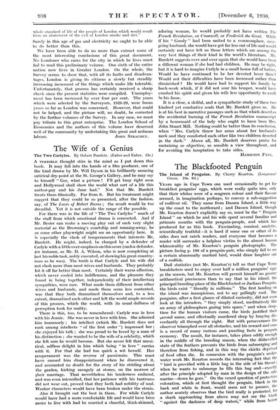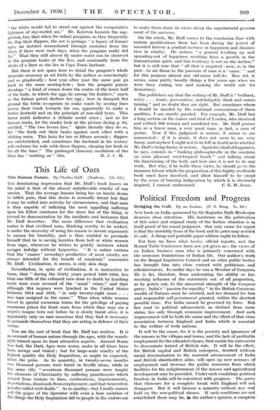The Blackfooted Penguin
The Island of Penguins. By Cherry Kearton. (Longman' Green. 10s. 6d.)
YEARS ago in Cape Town one used occasionally to get for breakfast penguins' eggs, which were really quite nice, only that their whites were of a seagreen colour and their flavour seemed, in imagination perhaps, to convey a sub-suggestion of codliver oil. They came from Dassen Island, a little way up the coast to the northward ; and Dassen Island, though Mr. Kearton doesn't explicitly say so, must be the " Penguin Island " on which he and his wife spent several familiar and intimate months with the penguin-people, and which has produced for us this book. Fascinating, comical, analytic, scientifically truthful—it is hard if some one or other of its sides does not catch readers, and everyone that becomes a reader will surrender a helpless victim to the almost human whimsicality of Mr. Kearton's penguin photographs. The picture facing p. 196 of a penguin-pair, who simply fail to sec a certain abnormally marked bird, would draw laughter out of a codfish.
Dull statistics (not Mr. Kearton's) tell us that Cape Town breakfasters used to enjoy over half a million penguins eggs in the season, but Mr: Kearton will permit himself no greater arithmetical preciseness than to say that in his island, the principal breeding-place of the Blackfooted or Jackass Penguin, the birds exist " literally in millions." The first landing on the island was inauspicious, not to say gallingly cool. The penguins, after a first glance of diluted curiosity, did not even look at the intruders, " they simply stood, meditatively like an army of philosophers gazing into space," and when sleep- time for the human visitors came, the birds justified their second name, and effectually murdered sleep by braying dis- cordantly all through the night. But with perseverance the observer triumphed over all obstacles, and his reward and ours is a record of many curious and puzzling facts in penguin economy. The moult, for instance, takes place oddly enough in the middle of the breeding season, when the dishevelled state of the feathers prevents the birds from submerging and therefore from fishing, and in this way the ehi(elcs deprived of food often die. In connexion with the penguin's under- water work Mr. Kearton records the interesting fact that the " bird is provided with a little bag in the side of his throat ; when he wants to submerge he fills this bag and—exactly after the principle adopted by man in the design of the sub- marine—down he goes." On the vexed question of protective coloration, which at first thought the penguin, black in the back and white in .front, would seem not to possess, the author acutely observes that the bird really is protected, for a shark approaching from above may not see the black
" against the darknesS of . deep ivateri," while tkinir below
"the white would fail to stand out against the comparative lightness of sky-roofed sea." Mr. Kearton hazards the sug- gestion, too, that when the infant penguins, as they frequently do, flap their flippers, the act is perhaps a legacy of former ages, an instinct remembered through centuries from the days, if there were such days, when the penguins really did fly." That they still almost fly under water can be observed in the penguin tanks at the Zoo, and ocasionally from the decks of a liner as she lies in Cape Town harbour.
But there is not space here to detail the penguin's whole domestic economy as set forth by the author so convincingly and so graphically : how year after year the same pair go back to the same nesting-hole ; how the penguin parent develops " a kind of crease down the centre of the lower half of the body, in which the eggs lie among the feathers," much as the fulmar petrel shelters her egg ; how in dampish flat ground the birds co-operate to make roads by scoring lines across their track towards the sea, apparently to make a better foothold and on the principle of non-skid tyres. This latter habit indicates a definite social sense ; and as for human traits, let the reader look at the picture facing p. 62, entitled, " The two lovers kiss." Quite literally they do so, for " the birds rub their beaks against each other with a clicking noise. This lasts for ten or fifteen seconds ; flippers are outstretched, and sometimes the husband in his ecstasy will embrace his wife with those flippers, clasping her beak in his all the time." The prolonged (human) osculation of the



























































 Previous page
Previous page